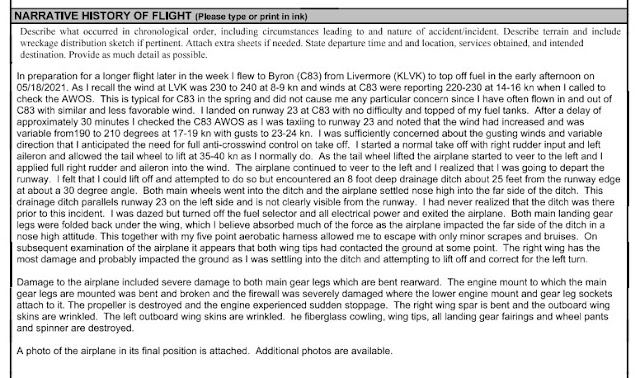
The National Transportation Safety Board did not travel to the scene of this accident.
Additional Participating Entity:
Federal Aviation Administration / Flight Standards District Office; Reno, Nevada
Investigation Docket - National Transportation Safety Board:
https://data.ntsb.gov/Docket
SkyKing Aviation Services LLC
Location: Minden, Nevada
Accident Number: WPR21LA215
Date and Time: May 30, 2021, 13:15 Local
Registration: N757ZZ
Aircraft: Cessna R182
Aircraft Damage: Substantial
Defining Event: Loss of control on ground
Injuries: 1 Minor, 2 None
Flight Conducted Under: Part 91: General aviation - Instructional
Analysis
The pilot receiving instruction reported that, during the first landing roll of the instructional flight, the airplane deviated slightly to the right and away from the runway centerline. The pilot receiving instruction corrected to the left and described the subsequent movement of the airplane as crabbing to the left while tracking down the runway. The flight instructor asserted that the pilot receiving instruction overcorrected with excessive left rudder and brake. The flight instructor told the pilot receiving instruction to get off the brake, and she applied right rudder. The instructor stated that the pilot receiving instruction “froze up” and she could not regain directional control of the airplane. The airplane exited the left side of the runway, nosed over and came to rest inverted. The airplane sustained substantial damage to the right-wing lift strut and the empennage.
The flight instructor and the pilot receiving instruction both reported that there were no preaccident mechanical failures or malfunctions with the airplane that would have precluded normal operation. At the time of the accident, the pilot receiving instruction was landing the airplane on runway 34 with variable wind at 5 knots, gusting to 11 knots.
Probable Cause and Findings
The National Transportation Safety Board determines the probable cause(s) of this accident to be:
The pilot receiving instruction’s failure to maintain directional control during the landing roll, and the flight instructor’s delayed remedial action.
Findings
Personnel issues Aircraft control - Student/instructed pilot
Aircraft Directional control - Not attained/maintained
Personnel issues Delayed action - Instructor/check pilot
Personnel issues Monitoring other person - Instructor/check pilot
Factual Information
History of Flight
Landing-landing roll Loss of control on ground (Defining event)
Flight instructor Information
Certificate: Commercial; Flight instructor; Private
Age: 26, Male
Airplane Rating(s): Single-engine land
Seat Occupied: Right
Other Aircraft Rating(s): Unmanned (sUAS)
Restraint Used: 3-point
Instrument Rating(s): Airplane
Second Pilot Present: Yes
Instructor Rating(s): Airplane single-engine
Toxicology Performed:
Medical Certification: Class 1 None
Last FAA Medical Exam: August 1, 2021
Occupational Pilot: Yes
Last Flight Review or Equivalent: February 18, 2021
Flight Time: (Estimated) 584 hours (Total, all aircraft), 69 hours (Total, this make and model), 85 hours (Last 90 days, all aircraft)
Pilot Information
Certificate: Airline transport; Commercial
Age: 60, Male
Airplane Rating(s): Single-engine land; Multi-engine land
Seat Occupied: Left
Other Aircraft Rating(s): None
Restraint Used: 3-point
Instrument Rating(s):
Airplane Second Pilot Present: Yes
Instructor Rating(s): None
Toxicology Performed:
Medical Certification: Class 1 With waivers/limitations
Last FAA Medical Exam: June 15, 2020
Occupational Pilot: Yes
Last Flight Review or Equivalent: September 3, 2020
Flight Time: (Estimated) 15000 hours (Total, all aircraft), 0 hours (Total, this make and model), 10000 hours (Pilot In Command, all aircraft)
Aircraft and Owner/Operator Information
Aircraft Make: Cessna
Registration: N757ZZ
Model/Series: R182 RG
Aircraft Category: Airplane
Year of Manufacture: 1979
Amateur Built:
Airworthiness Certificate: Normal
Serial Number: R18201278
Landing Gear Type: Retractable - Tricycle
Seats: 4
Date/Type of Last Inspection: April 30, 2021 Annual
Certified Max Gross Wt.: 1195 lbs
Time Since Last Inspection: 5039.3 Hrs
Engines: 1 Reciprocating
Airframe Total Time: 5095.2 Hrs at time of accident
Engine Manufacturer: LYCOMING
ELT: C126 installed, not activated
Engine Model/Series: 0-540
Registered Owner:
Rated Power: 250 Horsepower
Operator:
Operating Certificate(s) Held: None
Meteorological Information and Flight Plan
Conditions at Accident Site: Visual (VMC)
Condition of Light: Day
Observation Facility, Elevation: KMEV, 4726 ft msl
Distance from Accident Site: 0 Nautical Miles
Observation Time: 13:35 Local
Direction from Accident Site: 170°
Lowest Cloud Condition:
Visibility: 10 miles
Lowest Ceiling:
Visibility (RVR):
Wind Speed/Gusts: / 11 knots
Turbulence Type Forecast/Actual: /
Wind Direction:
Turbulence Severity Forecast/Actual: /
Altimeter Setting: 30.08 inches Hg
Temperature/Dew Point: 28°C / -7°C
Precipitation and Obscuration: No Obscuration; No Precipitation
Departure Point: Minden, NV
Type of Flight Plan Filed: None
Destination: Minden, NV
Type of Clearance: VFR
Departure Time:
Type of Airspace: Class G
Airport Information
Airport: MINDEN-TAHOE MEV
Runway Surface Type: Asphalt
Airport Elevation: 4723 ft msl
Runway Surface Condition: Dry
Runway Used: 16/34
IFR Approach: None
Runway Length/Width: 7399 ft / 100 ft
VFR Approach/Landing: Stop and go
Wreckage and Impact Information
Crew Injuries: 1 Minor, 1 None
Aircraft Damage: Substantial
Passenger Injuries: 1 None
Aircraft Fire: None
Ground Injuries:
Aircraft Explosion: None
Total Injuries: 1 Minor, 2 None
Latitude, Longitude: 39.0005,-119.75111 (est)




















































